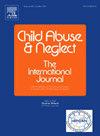儿童期威胁和剥夺与中国青少年网络使用问题的关系
IF 3.4
2区 心理学
Q1 FAMILY STUDIES
引用次数: 0
摘要
虽然不良童年经历(ACE)与青少年网络使用问题(PIU)之间的关联已经确立,但关于不良童年经历具体维度的作用的证据仍然有限。目的探讨ACE的两个维度(威胁和剥夺)对青少年PIU的影响,并探讨性别在这些关联中的潜在调节作用。本横断面分析涉及6714名11-20岁的青少年。通过自述问卷收集了6个与威胁相关的不良经历和6个与剥夺相关的不良经历。青少年PIU采用杨氏诊断问卷(YDQ)进行评估。采用Logistic回归分析来评估威胁和剥夺相关的ace与PIU的关系。分层分析和相互作用测试也被用来探讨性别的潜在调节作用。结果青少年中男孩占52.2%,平均年龄为14.5岁(标准差为1.6)。大约16.5%的青少年表现出PIU。与没有分别暴露于ACE的青少年相比,经历威胁或剥夺相关ACE的青少年发生PIU的可能性增加(威胁相关ACE≥2次的比值比[or]: 4.33, 95% CI: 3.60-5.221.66; or: 1.38, 95% CI: 1.14-1.66)。性别对ACE维度和PIU之间的关系没有显著调节作用。结论:解决青少年不良网络事件,特别是与威胁相关的不良网络事件,可能有助于促进青少年健康使用互联网。有必要进行进一步的研究,以了解潜在的机制,并根据特定的ACE维度为减少PIU提供有针对性的策略。本文章由计算机程序翻译,如有差异,请以英文原文为准。
Association of childhood threat and deprivation with problematic internet use in Chinese adolescents
Background
While the association between adverse childhood experiences (ACEs) and problematic internet use (PIU) among adolescents has been established, evidence on the role of specific ACE dimensions remains limited.
Objective
This study investigated the impact of two ACE dimensions, i.e., threat and deprivation, on adolescent PIU, and examined the potential moderating role of gender in these associations.
Participants and setting
This cross-sectional analysis engaged 6714 adolescents aged 11–20 years. Six threat-related ACEs and six deprivation-related ACEs were collected through self-reported questionnaires. Adolescent PIU was assessed using the Young’s Diagnostic Questionnaire (YDQ). Logistic regression analyses were conducted to assess the associations of threat- and deprivation-related ACEs with PIU. Stratified analyses and interaction tests were also conducted to explore the potential moderating role of gender.
Results
Among the adolescents, 52.2 % were boys, with an average age of 14.5 (standard deviation: 1.6) years. Approximately 16.5 % of adolescents exhibited PIU. Compared to those without the respective ACE exposure, adolescents experiencing either threat- or deprivation-related ACEs had an increased likelihood of PIU (odds ratio [OR]: 4.33, 95 % CI: 3.60–5.221.66 for ≥2 threat-related ACEs; OR: 1.38, 95 % CI: 1.14–1.66 for ≥2 deprivation-related ACEs). Gender was not a significant moderator in the association between either ACE dimension and PIU.
Conclusion
These findings suggest that addressing ACEs in adolescents, particularly threat-related ACEs, may be beneficial in promoting healthy internet use among adolescents. Further research is warranted to understand the underlying mechanisms and to inform targeted strategies for reducing PIU based on specific ACE dimensions.
求助全文
通过发布文献求助,成功后即可免费获取论文全文。
去求助
来源期刊

Child Abuse & Neglect
Multiple-
CiteScore
7.40
自引率
10.40%
发文量
397
期刊介绍:
Official Publication of the International Society for Prevention of Child Abuse and Neglect. Child Abuse & Neglect The International Journal, provides an international, multidisciplinary forum on all aspects of child abuse and neglect, with special emphasis on prevention and treatment; the scope extends further to all those aspects of life which either favor or hinder child development. While contributions will primarily be from the fields of psychology, psychiatry, social work, medicine, nursing, law enforcement, legislature, education, and anthropology, the Journal encourages the concerned lay individual and child-oriented advocate organizations to contribute.
 求助内容:
求助内容: 应助结果提醒方式:
应助结果提醒方式:


